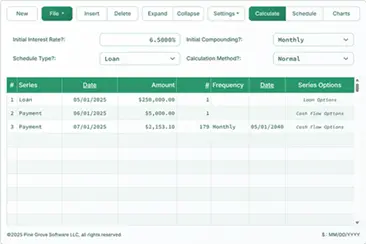Buy vs Renting a House?
Should you buy or rent?
There's not a single answer to the question if you should rent or buy a house. The details for everyone are different from every other person's needs and resources.
This mortgage calculator will account for all the financial aspects of a rent vs. buy analysis so that you may answer this question for yourself. Here's what you should be considering.
Items that impact the cost of homeownership:
- mortgage interest
- costs to obtain a mortgage, i.e., points, fees, etc.
- property taxes
- property insurance
- possibly private mortgage insurance (PMI)
- maintenance
- property appreciation rate
- inflation rate for costs
Items the impact the cost of renting:
- rent
- rent inflation
The discussion that follows assumes you understand how to calculate a mortgage payment using this calculator. If something is not clear, please see the additional documentation here.
Details are below…
The Calculator-Calculate Down Payment, Payment, PMI, Rate and Term
Information
NOTICE - Always enter (and reenter) a 0 if you want a value calculated.
Since the calculator does not recalculate the payment when the mortgage amount changes (for example), users can create an amortization schedule with whatever payment amount they desire.
Notes about the rent vs. buy calculation
This calculator creates a printable, annualized Inflation-Adjusted Cost and Appreciation Schedule in addition to the payment table. To create the schedule, make sure you check this setting on the Options Tab:
- Check to include a cost & appreciation schedule after loan schedule

The bottom line of the rent vs. buy analysis is expressed in dollars here:
- Difference Cost-to-Own vs. Rent
The result is all the inflation-adjusted homeownership costs (Total Cost-to-Own) less the sum of the inflation-adjusted rent (Total Rent (fixed costs)). Thus a negative value means that renting is more expensive than buying.
One perceived benefit of homeownership missing from this analysis is the impact of U.S. income tax deductions. The tax benefit of ownership is not what it use to be. Ever since "The Tax Cuts and Jobs Act of 2017 (TCJA)" (and we assume this will not change after the passage of One Big Beautiful Bill Act of 2025), fewer folks itemize their deductions. However, this remains to be seen since some limits on the deductions have changed. In any event, tax benefits are not included, as noted in the report.
See this Investopedia article for details.
You are free to account for the possible tax benefits by using the total tax benefit from the payment schedule, deducting it from the total cost-to-own, and recalculating the above subtraction result.
How to use the ROR
The Annualized Rate-of-Return is a net calculation. That is, to make the ROR meaningful, we deduct the rent (you have to live somewhere after all) as a fixed cost from the total cost of homeownership. If you are ready to pay $20,000 a year for rent, then the calculator's analysis will look at the difference in costs to calculate the ROR.
This is why the calculator can show a gross dollar loss and yet show a positive ROR. The ROR is the rate-of-return on the amount you spend above the cost of renting (i.e., minimum shelter).
Why do we calculate the ROR this way?
Suppose your net ROR is 2%, and you earn 5% investing. In that case, you might want to consider renting and investing the difference, even if the rent vs. buy calculation indicates that renting is the more costly option.
These settings will impact your buy vs. rent decision
Found on the "Options" tab:
- Points - calculated using the loan amount, they are reported in the first row of the schedule. One point is one percent of the mortgage loan amount. Points, by themselves, increase the APR. However, borrowers pay mortgage points to obtain a lower interest rate. The combination of points and the lower rate should result in an overall lower APR. Check the APR option to find out. (optional)
- Other Charges & Fees - borrowers will frequently have to pay one-time fees when applying for a mortgage. These fees and charges also impact the APR calculation. It is essential to understand what charges to include. Background APR information (optional)
- Annual Property Taxes - are included in the escrow column on the schedule. Please be sure to enter a yearly amount in the calculator. (optional)
- Annual Insurance - the escrow column on the mortgage schedule also includes property-casualty insurance. (optional)
- Private Mortgage Insurance (PMI) - the lender may require PMI if your loan-to-value (LTV) is more than 80%. That is, your down payment frequently needs to be 20% or more to avoid PMI. (optional)
- Your Marginal Tax Rate - used to calculate the personalized tax benefits of a mortgage. (optional)
- Annual Maintenance - used in total homeownership cost and rent vs. buy analysis (optional)
- Monthly Rent - used in the rent vs. buy analysis (optional)
- Property Appreciation Rate (est) - estimated annual house price appreciation. Used to calculate a potential selling price for the property at the end of the mortgage. (optional)
- Average Inflation Rate on Costs - Enter an estimated inflation rate. The calculator will adjust the ownership costs and rent by this rate. (optional)
- Include in ROI Calculation - when calculating an ROI, you may include only the mortgage cost or the mortgage and other costs such as maintenance. Background ROI information
A thorough rent vs buy analysis can be daunting. If something is not clear, you may leave your question in the comments below

Comments, suggestions & questions welcomed...